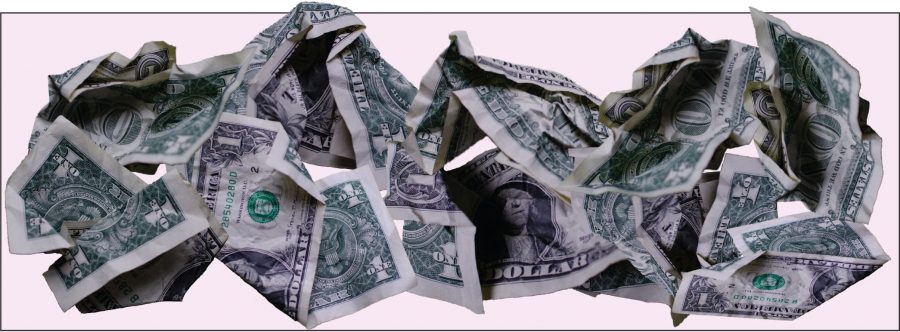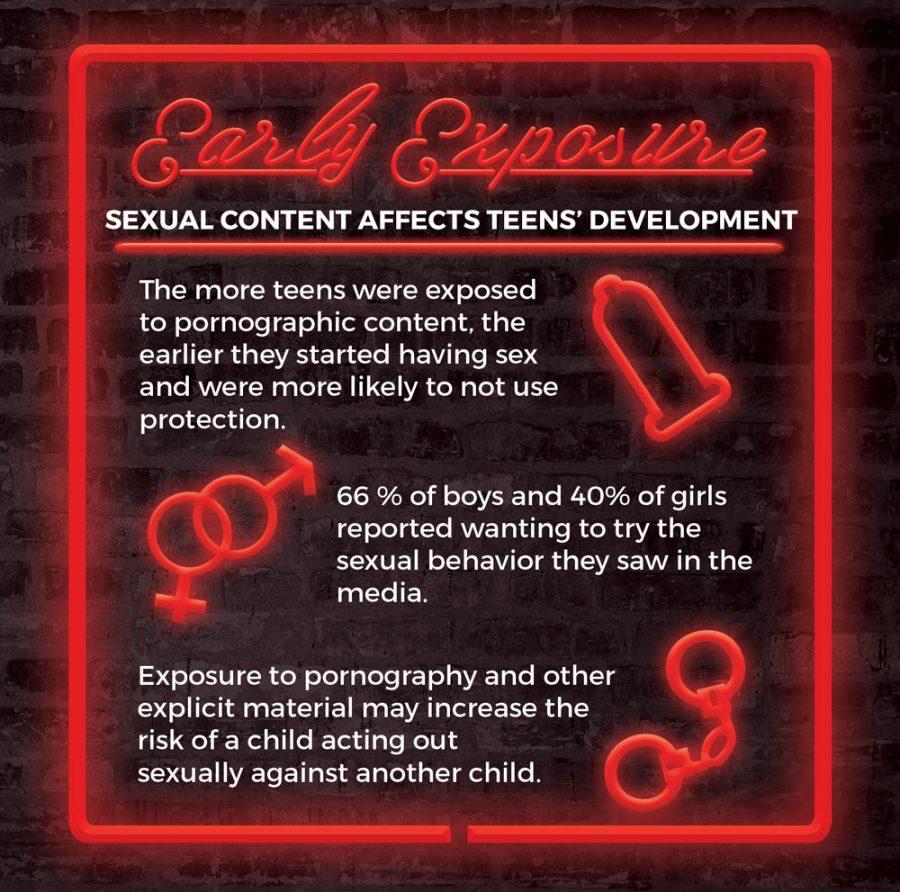More and more men are consuming pornography with ease of access, but what does it mean for health?
[vc_text_separator title=”First in a three part series on pornography” color=”custom” accent_color=”#990500″][vc_empty_space height=”15″]Clearasil’s newest commercial declares “Acne won’t last forever. Just like your mom won’t walk in on you forever.”Next a young boy is shown at his laptop. His mom enters the room, gasps; he slams his computer shut, and she yells, “Stephen!” with a horrified look on her face.
Last year pornography and masturbation had become so normalized that they landed themselves in a televised commercial.
The idea of fixation on the sexual features of women isn’t new, of course. Deep-seeded beliefs that women are objects to be enjoyed by men, mainly in sexual and domestic terms, have been present throughout history, sociology teacher Joshua Nothom said.
“We live in a patriarchal society, meaning our society has a disproportionate amount of men in positions of power. Throughout history, women have been objectified and assigned a certain role in society,” Nothom said. “Although societal norms are slowly changing, Americans are still being socialized to focus on a woman’s sexuality, rather than a woman’s holistic offering to society. Sexual socialization starts at a young age through cartoons and advertising – and many Americans are oblivious to it.”
So while sexualizing the female form isn’t new, people are now beginning to accept sexuality and are willing to talk about many different features of it.
Senior Clayton Warder attributes this to today’s social climate, saying that viewing pornography “is getting less taboo as society gets more and more sexual and open.”
Pornography is certainly being viewed by the masses; in 2006 the world pornography revenue was $97 billion, more than Microsoft, Google, Amazon, eBay, Yahoo, Apple and Netflix put together. Young men specifically are highly likely to use porn. About 68 percent of teenage boys watch pornography at least once a week.
But the accessibility and acceptance of pornography didn’t always exist. Sexuality and how people define it has ebbed and flowed throughout time, with some cultures embracing and others shaming nudity and sex.
“Historically, sexuality has run a fine line between deviant and acceptable, and it changes from generation to generation, from culture to culture. If we flash back to the days of the Roman empire, what would be considered pornography today, was proliferating throughout high society. In fact, recent archeological discoveries have unearthed depictions of human sexuality in the preserved locations of Herculaneum and Pompeii,” Nothom said. “However, in American society, strict restrictions are placed upon viewing what are considered to be pornographic images. In the 1990s, Mayor Giuliani ‘cleaned up’ Times Square in New York City. Times Square was once the home of several adult theaters, adult stores, peep shows, those kinds of things, definitely not the family friendly vibe that it has 20 years later.”
The age of conservatism, spearheaded by President Ronald Reagan, brought about change like the kind Nothom spoke of in New York City, in what was accepted and what was considered too obscene.
The Supreme Court case Miller v. California (1973) exemplifies the era and its feelings towards pornography and sexuality.

“When I did my dissertation it was on some guys who grew up in the ’80s. It was just the transition from magazines to VHS. I think in the past it was much harder to gain access. What was available was somewhat limited and in some sense tame compared to what is available now,” Dr. Mark Adams, a licensed psychologist in Austin, said. “It has changed where relatively quickly you can access a whole spectrum, including really complicated and awful child pornography and bestiality. I think it has dramatically changed the landscape of what is available and [what is out there] is so broad compared to historically where it was just discovering dad’s Playboy. Now you can get on the web at any age and access all of these kinds of images and videos that are much more complicated than the images in Playboy and Penthouse.”
For his PhD dissertation, Dr. Adams worked with men and dove into their pornographic history, helping both him and his patients to learn the impacts of pornography on their lives, relationships and sexual drives. Many men tended to have compulsions to view pornography that sometimes became uncontrollable, bordering on addiction.
Dr. Adams has created an operational definition of addiction to use in his practice. This helps him assess when a compulsion has gone too far and should be labeled as something more serious.
“My working definition of addiction comes from just my own reading, but two things seem to happen. One, there are repeated efforts to stop the behavior and you can’t or you have limited episodes of sobriety,” Dr. Adams said. “The second one is that you continue to use despite negative consequences. In my practice, sometimes the girlfriend or partner may discover it and creates an ultimatum or a crisis and they may stop for a short period time and then start up again.”
With 35 percent of teenage boys saying they have viewed pornography too many times to count, according to CovenantEyes, talking openly about viewing porn and masturbating is common. But is addiction also becoming more talked about and prevalent? Warder has noticed the influx of discussion surrounding pornography and sees the possibility of addiction as a risk factor that comes with any habit.
“I think simply as more people access the internet, and it becomes more available, there is bound to be an increase in watching porn,” Warder said. “Just as there is a concern for addiction with everything, there is a concern with porn addiction.”
Whether addiction to pornography was under-reported in the past, or whether it’s on an upward trend, Dr. Adams attributes this growing number to society’s relatively new acceptance of consuming pornography. The question that remains is who gets addicted to porn, and Dr. Adams isn’t sure he has an answer.
[quote cite=”Dr. Mark Adams, psychiatrist “]I do think it is important for boys and men to have conversations about what is this thing that we are using and what impacts does it have? Is it really good for us, good for our culture and good for our relationships?[/quote] “There is a normalization now that everyone gets exposed to pornography because of the internet and because of its accessibility. Why does it continue for some people in more compulsive ways? I am not sure what my own answer to that would be,” Dr. Adams said. “I think maybe certain vulnerabilities. It could be social awkwardness or avoidance, but at the same time I have seen people who are in relationships or marriages and they have that and they still continue to use porn. So I don’t know entirely why it is that some people seem to develop a more addictive approach to it.”
All controversy aside, science does tout a series of negative effects caused by sex and pornography addiction. Mayo Clinic’s site states, “Cellular adaptations in the [pornography] addict’s prefrontal cortex result in increased salience of drug-associated stimuli, decreased salience of non-drug stimuli and decreased interest in pursuing goal-directed activities central to survival.”
This means that those addicted to pornography are at a higher risk of becoming drug addicts or alcoholics and may become depressed, causing a slew of other harmful symptoms.
Besides this, Mayo Clinic notes those with what it calls “compulsive sexual behavior,” which includes those addicted to pornography and those addicted to sex, may lose their focus at work, struggle with feelings of shame and guilt, develop anxiety or extreme stress, destroy relationships with their family or partner because of lying about the activity and accumulate financial debt by buying excessive amounts of pornography or sexual services.
There are several warning signs of pornography addiction, according to CovenantEyes, including the loss of interest in sex, a change in sexual interests, spending an excessive amount of time on the internet and becoming antisocial, withdrawn or evasive.
In his practice, Dr. Adams often works with men who identify as pornography addicts or as a consumer of porn who wants to lessen his draw to it.
“Usually they are interested in looking at their consumption critically,” Dr. Adams said. “Maybe they are recognizing that it is affecting their relationship or that it is creating problems or they are siphoning off sexual energy from this relationship into this other behavior in secret.”
After they have admitted and recognized the problem, Dr. Adams takes a variety of approaches to address the behavior and work on reducing or eliminating it. But first, the patient and he have to identify what they want to accomplish in their sessions.
“Usually there are three things I do. One is collaborate with them about the behavior. Do they want to eliminate it or reduce it? Do they want to gain more understanding of why it is there or how it developed? I have seen it develop in times of stress as a stress coping strategy and it is used to take care of themselves if they are frustrated or bored. It becomes a habit that they are not really mindful of and it seems to get out of hand. The second part is how can we understand how this developed? So I will often do a porn history. How did they first encounter it? Why has it continued to be compelling for them? Lastly is developing other ways of taking care of themselves. If they have the impulse, what could they do instead? That could be anything from exercise, to mediation, to take a walk, or to even talk with somebody, including their partner.”
But many other pornography consumers do not feel a compulsion to view pornography; they simply view at their leisure. So that is OK, right? Well, the answer to that question isn’t black and white.
Nothom sees positives and negatives, acknowledging that either condemning or glorifying is a question of values and beliefs guided by a moral compass that points different directions for everyone.
“I think safe, personal expression of human sexuality could be a positive aspect of the culture of pornography, assuming it’s between two consenting adults. There are also positive economic impacts to those involved as well,” Nothom said. “I think negative aspects could be the continued objectification of women, threat of disease and exploitation if regulations are not followed, and of course the wide availability to minors because of the internet.”
Warder acknowledges several problems with pornography, as well, from objectification to skewing thoughts regarding sexual relationships.
“I think if you ever reduce someone down to just physical attributes, which is all porn is, it can be dangerous,” Warder said. “I believe that it can affect people’s thoughts and give unrealistic expectations of what their significant other wants. If someone watches porn and thinks that’s how everything should be, I think that is dangerous.”
Dr. Adams has honed in on Warder’s critique of pornography and relationships in his research. He believes if men are used to getting aroused by images and videos, it can be hard for them to adjust to dealing with the emotions and thoughts of a real person in a sexual relationship.
“They are conditioning their body to get turned on in certain ways with the use of images as opposed to a real person. I think what I have found is that it creates complications with dealing with the whole spectrum of a sexual relationship and the subjectivity of another person, let alone all the other kind of aspects of being involved with someone,” Dr. Adams said. “Whereas pornography, you use the image, get off and then you put the image away. You don’t have to deal with another person. It may affect the ability to be present in a sexual relationship.”
Besides impacting the dynamics of a relationship and the way a man treats his partner, violent pornography also changes the way a man may treat his partner sexually. While Dr. Adams can’t say pornography displaying physical violence causes definite aggressivity issues, he is concerned about its possible implications on the psyche of its viewers.

Like Warder and Nothom, Dr. Adams has tried to tackle the question of pornography’s virtue and vice. He regularly works with the negatives, but in his research he has come across positives, as well. Unfortunately, he believes the detriments largely outweigh the potential benefits.
“The positives may be that sometimes pornography may give someone the opportunity to experiment and explore sexual feelings. It may be more important for a gay or lesbian person who may not have access to images of how gay sex works,” Dr. Adams said. “I think sometimes it might be useful, but I think by and large it is a problematic cultural form. I look at it the same way that I look at fast food or McDonald’s. In moderation it might be OK, but overall I think it is a bad product, even when done well.”
Dr. Adams doesn’t merely want to write off pornography as bad, he wants to encourage “a spirit of questioning” and encourage men to think critically about this sometimes mindless and possibly dangerous part of their lives. He thinks it is important for men themselves to evaluate pornography, which is the main reason he chose to delve into the topic throughout his graduate education.
“The reason that I got into it was because in graduate school and in college all the people that were talking about pornography were women. It was this interesting turn because historically, women have criticized men speaking for them, but in this topic, women were doing the speaking for men,” Dr. Adams said. “In my own perspective, I think for change to happen, men have to start to talk about and look at this critically. They are not going to necessarily listen to women’s perspectives on what pornography does or doesn’t do, unless there is a crisis in a marriage.”
His hope is that men begin to start conversations about pornography from the production, those involved, those viewing, to even themselves and their own consumption instead of hiding this part of their lives from others.
“My own thought is that we need to develop men to think more critically. In my perspective a lot of men don’t. They’d rather not talk about it. Even though it has become more mainstream, it still has the little tinge of controversy or it is done in secret. It may not be talked about directly or talked about it in any meaningful way,” Dr. Adams said. “I do think it is important for boys and men to have conversations about what is this thing that we are using and what impacts does it have? Is it really good for us, good for our culture and good for our relationships?”
background art by Neil Cathro
What do you think about the effects of pornography? Are you OK with this new ‘cultural form’ or are you concerned with its widespread use? Tell Bearing News in the comments below.




















































































